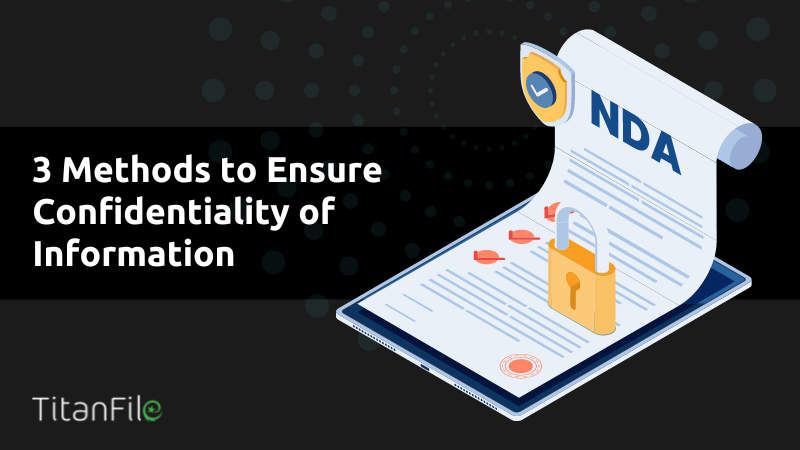In an increasingly interconnected digital world, the confidentiality of information has never been more crucial. From personal data to proprietary company information, every byte of data has inherent value and potential risk if left unprotected. Whether you’re a business owner seeking to protect your trade secrets, an employee tasked with safeguarding customer data, or an individual striving to keep your personal information private, understanding how to ensure data confidentiality is imperative. This blog post will guide you through “3 methods to ensure confidentiality of information”: crafting ironclad confidentiality agreements, preventing unauthorized access, and fostering a culture of confidentiality.
Key Takeaways
- Effective confidentiality agreements, such as NDAs and tailored employment clauses, are critical legal tools to protect sensitive information and prescribe consequences for unauthorized data breaches.
- Technical safeguards like robust data encryption, secure management of physical documents, and consistent access reviews with audit trails are crucial in preventing unauthorized access and ensuring data confidentiality.
- Creating a culture of confidentiality through employee training programs, clean desk policies, and secure disposal practices, alongside a well-structured incident response plan, is essential for maintaining data security within an organization.
1. Crafting Ironclad Confidentiality Agreements
Confidentiality agreements, often known as non disclosure agreement (NDA), are legally binding contracts designed to protect sensitive information. Whether you’re establishing a new business relationship, hiring an employee, or sharing proprietary information, a well-crafted confidentiality agreement can be your first line of defense against unauthorized disclosure and potential data breaches.
You might wonder how to create an effective confidentiality agreement, what elements it should contain, and the legal implications of breaching such an agreement. We will analyze these aspects.
Non Disclosure Agreements (NDAs) for New Relationships
NDAs serve as a protective shield, ensuring the confidentiality of sensitive information disclosed during business transactions. They hold paramount significance in fostering new relationships as they provide legal protection against unauthorized disclosure, thereby instilling a sense of trust and security between parties. This legal safeguard extends to various types of sensitive information, including:
- trade secrets
- business strategies
- customer lists
- financial data
- marketing plans
- research and development details
Drafting an NDA, however, is not a one-size-fits-all process. The agreement must be tailored to the specific needs of the relationship and the nature of the information involved. The process includes:
- Identifying the parties involved
- Describing the scope of the protected data
- Specifying each party’s obligations and responsibilities
- Outlining any exclusions
- Setting the term of the NDA
- Defining the consequences for violations.
Keep in mind, a well-constructed NDA can serve as a powerful tool for the protection of confidential information.
Tailored Clauses in Employment Contracts
While NDAs are essential in new business relationships, confidentiality clauses in employment contracts are equally important. These clauses bind employees legally to maintain the confidentiality of specific company information, preventing unauthorized disclosure, and safeguarding the interests of the company and its clients. Whether it’s a high-level executive or an entry-level employee, anyone with access to company data should be legally bound to maintain its confidentiality.
The crafting of these clauses requires precision and understanding. The clauses must clearly define:
- What constitutes confidential information
- The duration of the confidentiality obligation
- Repercussions for violating the clause
- Any exemptions or exclusions
Note that a carefully constructed confidentiality clause not only safeguards your company’s confidential information but also private information. It enlightens employees about their responsibilities in handling a confidential document and the importance of not discussing confidential information, thus helping them maintain confidentiality.
Enforceability and Legal Repercussions
So, you’ve drafted a comprehensive confidentiality agreement, but is it enforceable? An enforceable confidentiality agreement must satisfy the fundamental requirements of a contract, including clear terms and conditions, mutual consent of the parties involved, and the exchange of consideration. It should also explicitly outline the protected confidential information, the duration of the confidentiality obligation, and the remedies for breaches. Guaranteeing enforceability is crucial for upholding the integrity of your agreement.
Now, what happens when a confidentiality agreement is breached? The legal repercussions, including legal obligations, can be severe. From filing breach of contract claims and seeking financial damages to addressing any related reputational damage or missed business opportunities, the violator can face serious consequences. Recent court cases, such as the conviction of Uber’s former Chief Security Officer for covering up a data breach, underscore the strict enforcement of confidentiality agreement terms.
2. Preventing Unauthorized Access

While legal agreements are imperative, technical measures to ensure data confidentiality and prevent unauthorized access to sensitive information are equally crucial. The security of your data hinges on your ability to protect it during transmission, storage, and access. This involves robust data encryption, implementing physical security protocols for sensitive documents, and carrying out regular access reviews and audit trails.
We will examine each of these elements more closely, considering the data collected.
Data Encryption in Transit and At Rest
Encryption is akin to a secret code that turns your data into an unintelligible form, accessible only to those with the right key. It serves as a formidable barrier to unauthorized access. Data encryption comes in two forms: in transit and at rest. Encryption in transit protects your data as it travels from one place to another, ensuring that even if it is intercepted, it remains unreadable. Standard protocols like SSL (Secure Sockets Layer) or TLS (Transport Layer Security) are commonly employed to uphold this level of security.
On the flip side, data encryption at rest safeguards your data stored. Whether it’s on a hard drive in your office or in a cloud storage platform, data at rest is a potential goldmine for hackers. Encryption ensures that even if they breach your storage, the data remains a jumbled mess without the decryption key. Adopting this dual method of encryption is fundamental to data security, thereby ensuring the protection of your sensitive information during transit as well as storage.
Companies in legal, finance, government, and healthcare trust TitanFile to securely in encrypt their information.
Physical Security Protocols for Sensitive Documents
While digital data security is vital, we must not forget about the physical security of sensitive documents. Whether it’s a confidential contract or a client’s personal information, physical documents are a tangible target for unauthorized access. Implementing physical security protocols for these sensitive documents is thus paramount.
A robust physical security strategy includes:
- A secure storage system, such as locked cabinets or safes
- Access control measures like key cards or biometric authentication
- Proper document destruction protocols
- Surveillance systems to deter potential thieves
- Controlled access environments to ensure only authorized individuals can access sensitive documents
Keep in mind, a robust data security strategy incorporates both digital and physical protections, including password protected measures.
Regular Access Reviews and Audit Trails
Beyond encryption and physical security, regular access reviews and audit trails are integral to preventing unauthorized access. Regular reviews ensure that access to sensitive data is granted on a need-to-know basis, adhering to the principle of least privilege. This minimizes the risk of inadvertent or intentional data breaches, providing stringent oversight of data confidentiality.
Audit trails, on the other hand, offer a comprehensive log of all activities performed on the data. This transparency allows organizations to monitor who has accessed the data, when, and any modifications made. In the event of a breach or unauthorized access, audit trails help identify the individuals responsible and ensure their accountability.
Therefore, conducting regular access reviews and maintaining comprehensive audit trails are fundamental for sustaining data security.
3. Fostering a Culture of Confidentiality

While legal agreements and security measures are vital, fostering a culture of confidentiality within your organization can significantly enhance data protection. This involves:
- Comprehensive training programs to educate employees on best practices
- Implementing a clean desk policy and secure disposal practices
- Developing an incident response plan for potential breaches
We will investigate these strategies further.
Comprehensive Confidentiality Training Programs
Employee training is a critical factor in maintaining data confidentiality. Regular, comprehensive training enhances employee awareness of potential risks and promotes best practices for data handling and password management. Training should cover the importance of confidentiality, potential consequences of breaching it, and laws and regulations that govern data protection. Customizing training to address specific business needs and ensuring team buy-in are critical to its success.
Note that ensuring data confidentiality is not a single task; it demands continuous commitment. Therefore, regular training sessions should be held, keeping employees up-to-date on evolving threats and security measures. A well-trained team can serve as the first line of defense against data breaches.
Clean Desk Policy and Secure Disposal Practices
Employees are required by a clean desk policy to remove confidential documents from their desks and workspaces at the end of each day. This practice helps maintain a secure and organized work environment. This simple practice can significantly reduce the potential for unauthorized access to sensitive materials. But a clean desk policy should extend beyond physical documents. Digital storage devices should also be cleared at the close of the workday, ensuring that sensitive data isn’t left exposed.
Secure disposal practices complement a clean desk policy by eliminating sensitive information effectively, preventing unauthorized access, and safeguarding an organization’s integrity and reputation. This can be as simple as using multiple paper shredders or as sophisticated as hiring a confidential recycling company. Bear in mind that the safeguarding of sensitive data spans from its inception to its disposal.
Incident Response Plan for Potential Breaches
In the event of a breach, a well-defined incident response plan allows for a prompt and effective response. This plan should outline the following:
- Mission and goals
- Roles and responsibilities of the response team
- Preparation and documentation
- Steps for detection and analysis
- Containment
- Eradication
- Recovery
- Post-incident improvement
By clearly defining these elements, an organization can quickly assess damage, secure information, and take appropriate legal action.
Implementing an incident response plan has numerous benefits. It provides a structured approach to handle security incidents, enabling organizations to:
- Promptly detect, respond to, and recover from breaches
- Minimize the impact and reduce the risk of further damage
- Guarantee efficient control and containment of breaches
- Safeguard sensitive information
- Preserve data confidentiality
Summary
Ensuring the confidentiality of information is a multi-faceted endeavor. It involves crafting ironclad confidentiality agreements, implementing technical and physical security measures to prevent unauthorized access, and fostering a culture of confidentiality within your organization. Regular employee training, a clean desk policy, secure disposal practices, and a robust incident response plan can significantly enhance your data security. Remember, every piece of data has inherent value and potential risk. Protecting this data is not just a legal obligation but a commitment to your clients, your employees, and your business’s reputation. So, take the time to review your data confidentiality practices and make the necessary improvements. After all, the confidentiality of information is not just a necessity; it’s a responsibility.
Frequently Asked Questions
What are three 3 ways to ensure a client’s confidentiality is maintained?
To ensure client confidentiality, you can use secure communication channels, implement strict access controls, and regularly educate your staff on the importance of confidentiality.
What are 5 ways to maintain confidentiality?
To maintain confidentiality, consider implementing strict access controls, using encryption, training employees on best practices, regularly updating security measures, and establishing clear confidentiality policies. These steps will help safeguard sensitive information and mitigate potential risks.
Why are Non Disclosure Agreements (NDAs) important in new business relationships?
Non Disclosure Agreements (NDAs) are important in new business relationships as they provide legal protection for confidential information against unauthorized disclosure, thereby instilling trust and security between parties. This is crucial for safeguarding sensitive information in business dealings.
How does data encryption work?
Data encryption works by using an algorithm to transform data into an unintelligible form, preventing unauthorized access and ensuring that only authorized individuals can decipher and comprehend the data.
What is a clean desk policy?
A clean desk policy requires employees to remove confidential documents from their desks at the end of each day to prevent unauthorized access to sensitive materials.

